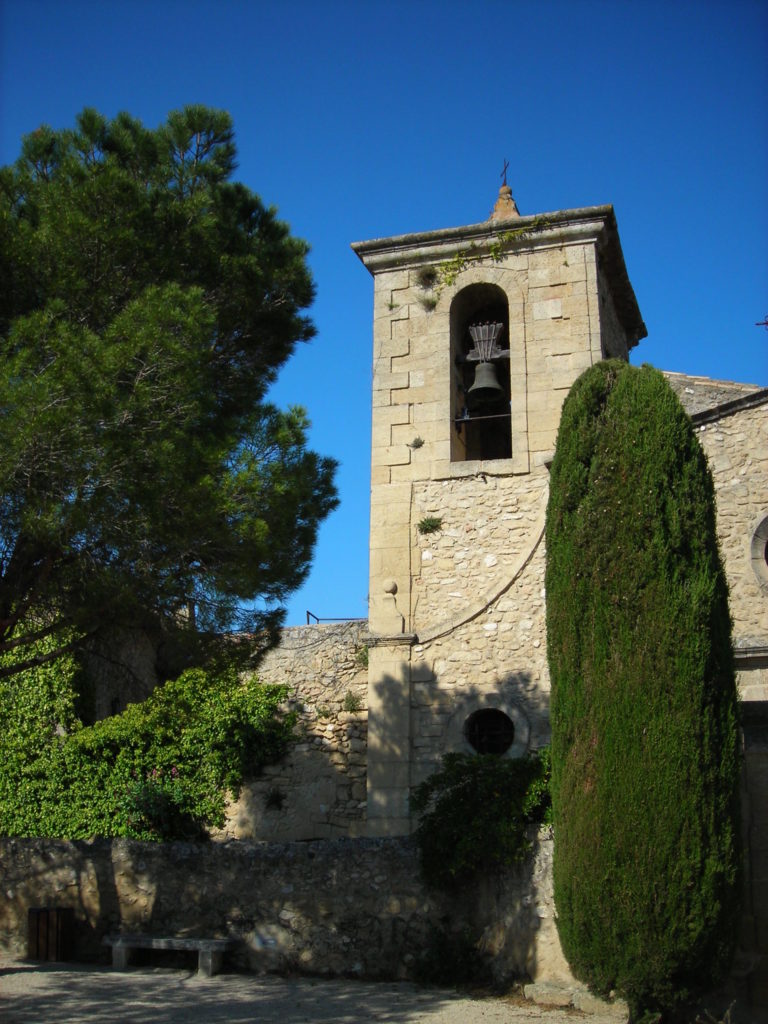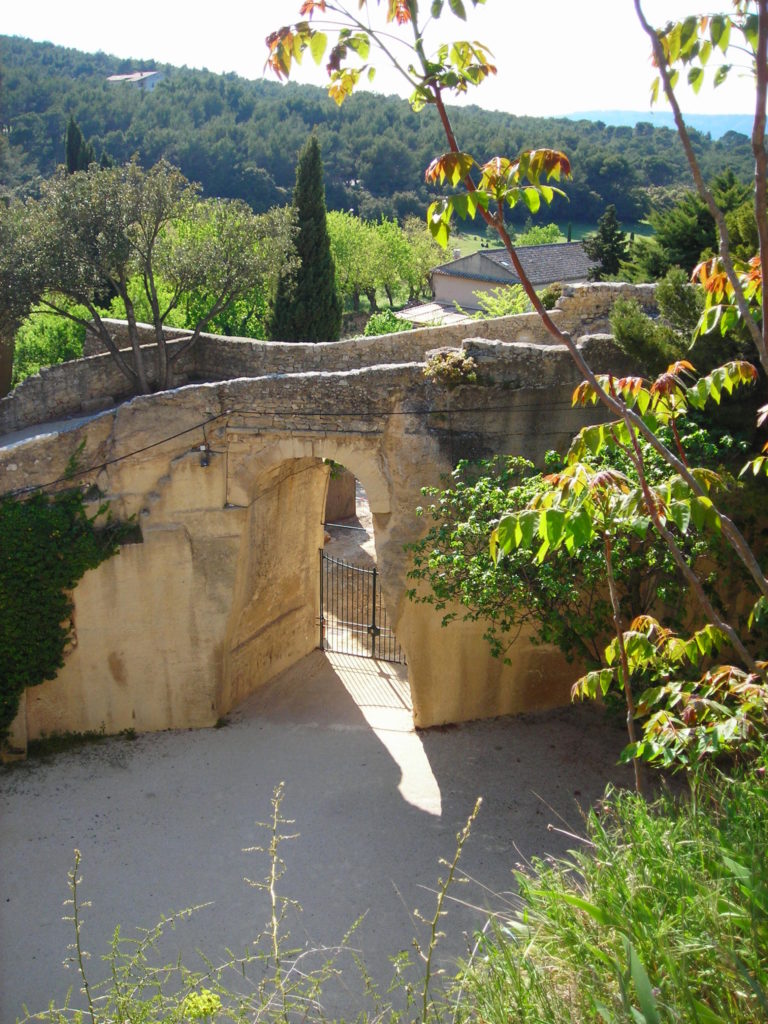La tour et la sculpture mystérieuse

A l’entrée du Vieux Village, une tour qui pourrait être le donjon d’un ancien château féodal se dresse sur un énorme bloc de molasse.
Dans la paroi rocheuse, vous remarquerez une étonnante sculpture en ronde-bosse, il s’agit du « Morvellous » (morveux en français).
Cette sculpture serait vraisemblablement le fait d’un ouvrier carrier du XIVème ou XVème siècle.
La tradition veut y voir « la figure de l’évêque Saint-Véran*, chevauchant le dragon qui terrorisait les provençaux, la crosse en main, la croix sur sa poitrine et deux écussons à ses pieds ».
Cette figure aurait une signification expiatoire : la légende raconte en effet que celui qui avait commis un délit était attaché à ce lieu.
Les villageois venaient lui jeter des pierres jusqu’ à ce qu’il en pleure.
* Saint Véran : d’après la tradition, cet évêque pieux aurait vécu au VI ème siècle et aurait délivré le pays de la Couloubre, monstre infernal.
L’Eglise des Taillades
L’église actuelle fut construite entre 1742 et 1760.
En 1760, dans le livre des comptes de la communauté, apparaît le paiement des honoraires au maître maçon Jean-Louis Berthet qui a « reconnu » les travaux de la nouvelle église.

En 1761, les consuls prennent la décision de faire refondre les cloches jugées trop petites. Elles seront baptisées le 21 novembre par le prêtre de l’époque, le curé Taxil. Le nom de sainte Luce est gravé sur la plus grosse, celui de saint Trophime sur la seconde.
Celles-ci prendront leur place définitive dans le nouveau clocher dont la construction est décidée le 9 décembre 1770. Il se situe au-dessus de la chapelle où se trouvent les fonts baptismaux et est accessible par un escalier extérieur.
Ayant subi les épreuves du temps, l’Eglise fut laissée à l’abandon pendant de longues années.
En 1940 elle fut rénovée en partie par un groupe de Lorrains rapatriés dans le village.
Malgré cela, l’état de l’édifice appelait d’urgentes réparations. C’est en 1982 que la commune entreprit des travaux importants de remise en état pour lui donner son aspect actuel.
La Carrière devenu le Théâtre des Carrières

Ce lieu est chargé d’histoire. Il est le témoin d’un passé où la pierre faisait vivre les Tailladais
(du Moyen Age jusqu’à la fin du XIXème siècle).
Cette carrière faisait peut-être partie de la liste des 12 recensées en 1873 lors d’une demande de construction d’une gare à Bel Air.
On y accède en passant sous un pont en pierre de taille. Son exploitation fut menée de telle sorte qu’elle préservait le chemin d’accès au village, tout en renforçant son système défensif. Il ne reste aujourd’hui que les parois verticales de ses fronts de taille pour se souvenir …
Cette carrière est devenue le Théâtre des Carrières. Chaque été de nombreux spectacles : concerts de jazz, de musique classique, théâtre, danse … donnent ainsi une nouvelle âme au vieux village. Quant aux autres carrières, elles sont des lieux de mémoire que l’on peut découvrir au hasard de promenades dans la colline.
Programmation : www.estivales-lestaillades.fr
THE TOWER (private property)
The tower is a relic of the old fortifications and was perhaps the keep of the feudal castle. It stands on a huge block of molasse. In the 1960s, Mr René Le Clerc, a distinguished mosaic artist, brought life back to the tower by setting up his studio in it. If you listen hard, you can imagine the squeaking of pencil on paper or the noise of the tools as he assembled the teserae … In the choir of the present church you will find a superb mosaic, created and donated by Mr Le Clerc in 1985, for the restoration of the place of worship.
THE « MORVELOUS » (« Snotty-nose »)
At the foot of the tower, this strange sculpture carved in the solid rock no doubt dates from the XIVth century. It is the work of a quarryman (or quarrymen) and depicts a bishop with his mitre and crozier. One can also make out two escutcheons. This is said to be Saint Veranus (bishop of Cavaillon in the VIth century) bringing down the dragon « Lou Couloubre ».
Why is it known as the « Morvelous » (Snotty-nose)?
It is said that, in the past, offenders were tied to this sculpture and the villagers threw stones at them until they wept … This sculpture was restored by a professional restorer in October 2019, by permission of the owner of the tower.
THE CHURCH OF SAINT TROPHIMUS
Before this building was built (between 1742 and 1760), the parishioners gathered in the original village church (XIth or XIIth century), which forms part of the old presbytery. An interesting document in Latin, dating from 1577, has been brought back from Rome. It is a report of a visit by the bishop of Cavaillon to the parish of Les Taillades. He recounts that : « The village of Les Taillades looks exactly like a village surrounded by seven high walls and its name no doubt comes from the fact that it is built very close to the rocks that are commonly won in large square blocks. The parish church is built within the walls and is dedicated to Saint Lucia, the virgin martyr, whose relics are preserved and whose feast day is celebrated every year. In this village there is a single priest to care for the population of not more than a hundred souls ».
In the XVIIIth century, the population of Les Taillades expanded and the old parish church proved too small. On 23 March 1740, the town councillors voted to have a new church built. A document dating from the same year refers to the removal of skeletal remains from the old cemetery, between the town hall and the church, so that the new building could be constructed. 1760 saw the « acceptance » of the works on the new building. Between 1780 and 1781, a « new » bell tower was built so that the two bells called after Saint Lucia and Saint Trophimus were under cover. In 1793, following the French Revolution, the property of the bishopric was confiscated and sold. At Les Taillades, it was the bells that were seized! The mayor sent one to Avignon … and was accused of supplying the smaller one! It was not till 1894 that it was replaced by a new bell cast in Rodez. Subsequently, the church was less and less well attended and indeed suffered
acts of vandalism. The years passed … a first renovation was carried out in 1940 by a group of refugees from Lorraine. Finally, extensive works were carried out by the municipality and the parish community in 1982, resulting in the present appearance of the church.
Inside the church, above the altar, can be seen the mosaic created by Mr Le Clerc when the church was restored in 1985. The artist explained his work « Saint Lucia in the footsteps of the risen Christ » in these terms: « In the footsteps of Jesus, in his light, Saint Lucia, guided by the Lord, wends her way towards the little church … She is its patron saint. She reminds the faithful of her painful ordeal in the year 305. So many centuries later, she now smiles again, happy to be able to pass on her message of peace, inviting us, too, to follow in the light of the risen Christ … »
A copy of a document from the XIIIth century states that the old church – like the new one several centuries later – was known by two names : Saint Trophimus and Saint Lucia. In the XIXth century, it was decided that the church would be called Saint Trophimus and the parish placed under the patronage of Saint Lucia.
THE QUARRY
This site, steeped in history, bears witness to a past in which the people of Les Taillades earned their living partly from stone working (from the Middle Ages to the end of the XIXth century). You enter by passing under a dressed stone bridge, which affords the only means of access to the old village. All that remains today to remind us of the past is the vertical quarry faces …
This site has become the Théâtre des Carrières. Every summer sees many events – jazz and classical music concerts, theatre, dance performances – which attract an enthusiastic public and breathe new life
into the old village. You may come across other workings when walking on the hill. In 1873, an application for a station to be built in the Bel Air area listed twelve quarries in Les Taillades.
Quarrymen’s tools
MASONRY HAMMERS – GOUGES – WEDGES – QUARRIER’S PICK – BUSHHAMMER